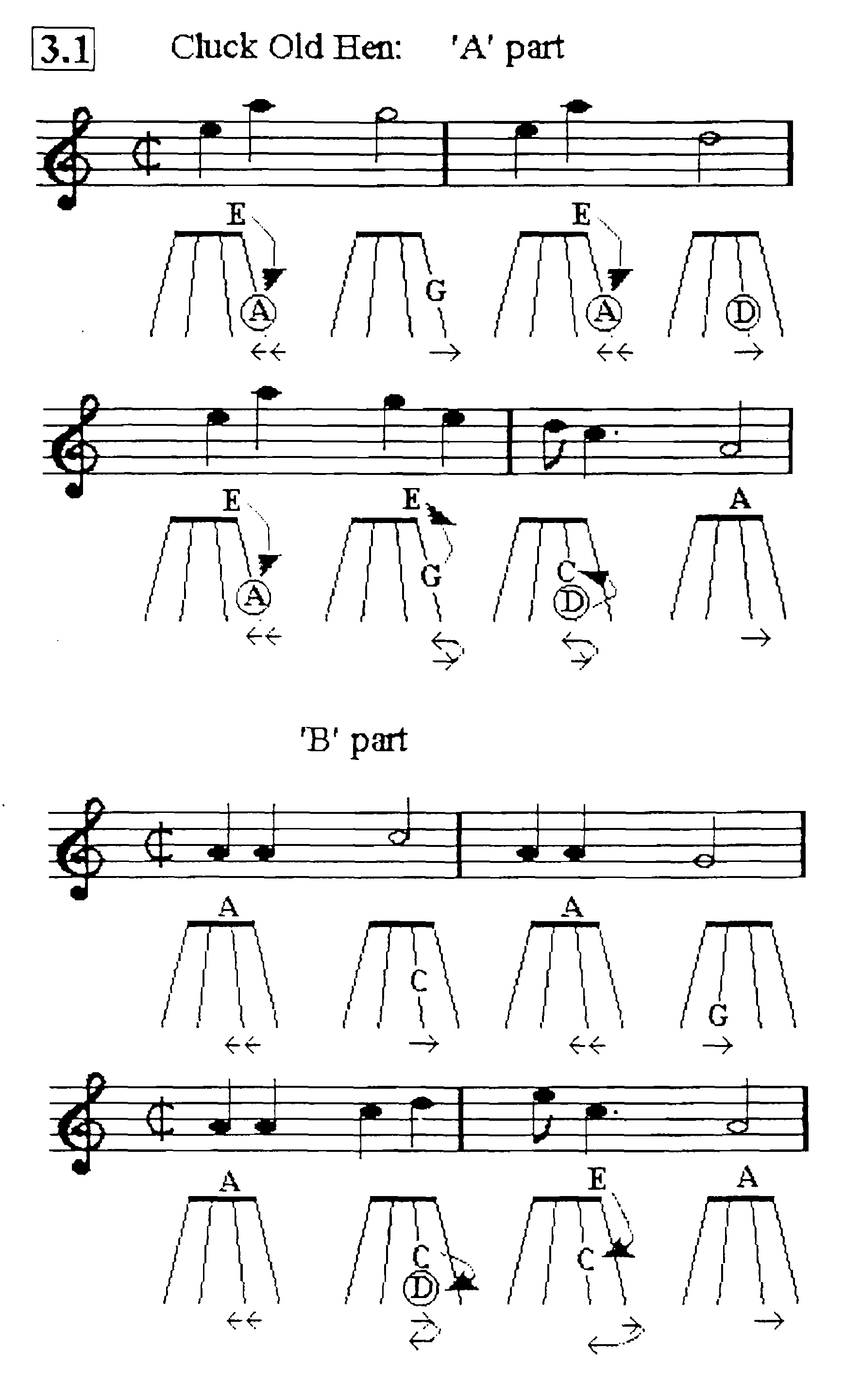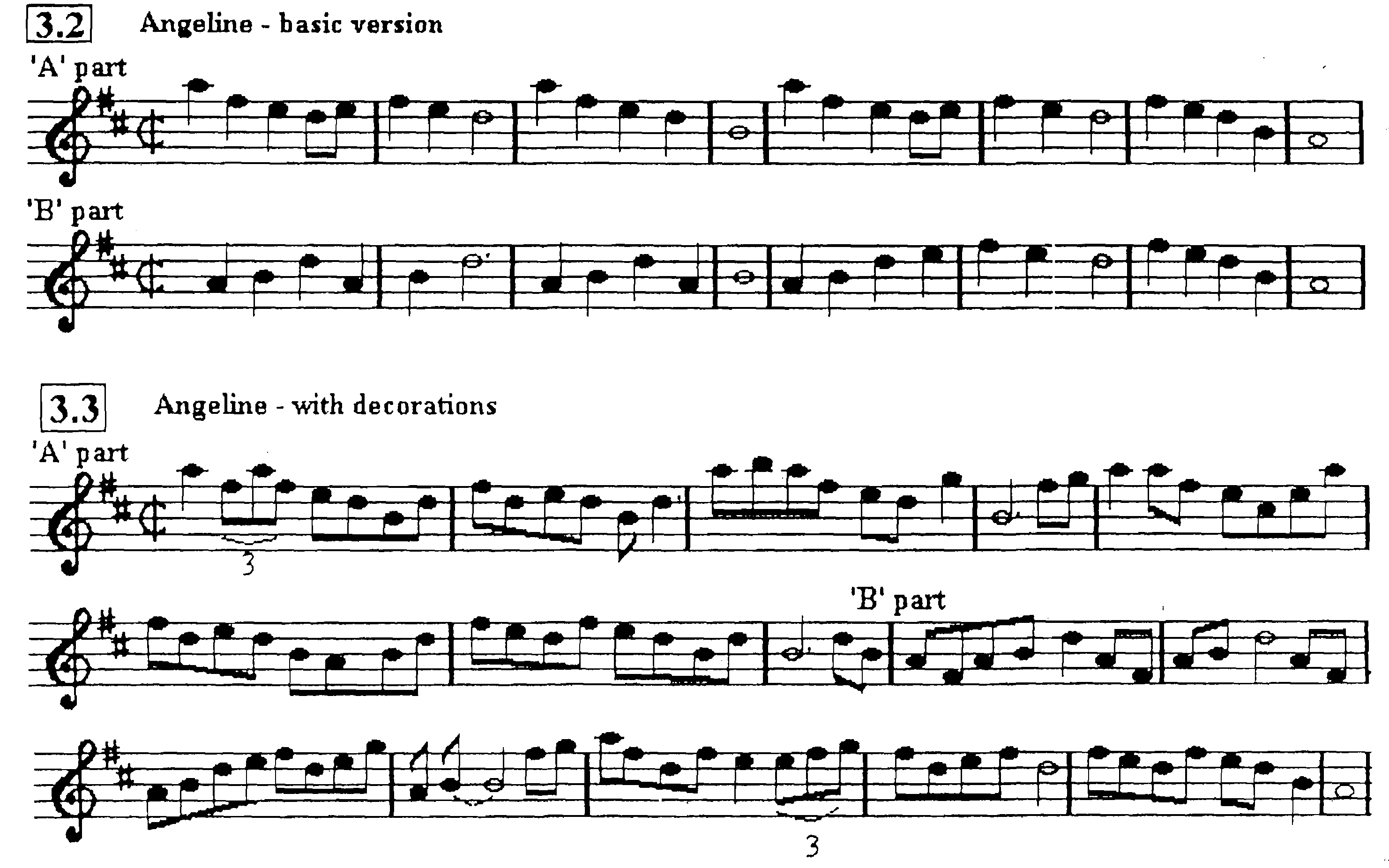Bluegrass Your Fiddle Part 3
Bluegrass Fiddle Tuition by Rick Townend
| Share page | Visit Us On FB |
Bluegrass your Fiddle Part 3
Tunes for Beginners
Here are a couple of tunes for beginners. Each in its basic form - which still sounds distinctly Appalachian - can be played with just two left hand fingers!
First, I assume that you've got the fiddle in tune; this is not as easy as with the other bluegrass instruments: the fiddle has no frets, so you can't check one string against another as you can on the guitar, banjo or mandolin, and the main bit of tuning is done with pegs that work by friction - not nice geared ones! So if you are having difficulty with tuning don't get disheartened - you may need to get assistance from another player or teacher for rather longer than with the other instruments. A pitch-pipe may help, or an electronic tuner - but do try to keep using your ear, as you'll need it all the time you play the fiddle. It's also fairly important to know the notes the strings are tuned to - G, D, A and E - that is unless you're going to learn by teaching yourself without reference to any other players, books etc..
So let's look at [3.1] - 'Cluck Old Hen'. This is a classic mountain tune with a lot of character, and is particularly suited to the fiddle which of all the bluegrass instruments makes the best 'chicken' noises! It's in the key of 'A' which, as you develop the tune, will enable you to get lots of extra drone notes by using the open A and E strings whenever you can, in addition to the tune notes. The tune has the usual dance-tune structure of two parts (usually called the ' A' part and the 'B' part, although this does not refer to the keys they are played in); it is shorter than the average tune in having only 4 bars to each part. Each part gets repeated, so a 'once-through-the-tune' consists of 16 bars the 'A' part twice then the 'B' part twice.
Try an intro first of all, using these two strings - A & E: use the 'Nashville Shuffle' - a long bow-stroke downwards and then two short ones up and down: then repeat in reverse - long up-stroke and short down and up. The rhythm is 'dah-di-di-dah-di-di. If you've listened to any bluegrass or old-timey music at all I'm sure you've come across this rhythm: it's also the standard frailing pattern on the banjo, and the kind of rhythm made by what Appalachian doggers call 'singles'. You can make the intro quite long to set the pace and feel, or use just a few shuffles if you feel it's getting boring.
The main main bit of tune then gets simpler rhythmically, and as I said above, the whole thing can be played using just two fingers - middle and ring. To get the placings, play the A and E strings together open, and then put your ring finger down on the E string, and move it about until it sounds a note exactly an octave higher than the open A string. This is the right place - it should be about 2'/2 inches (60mm) up the neck - and of course it is an A note. Try the same position on the A string -this will be a D note. Now go back to the E string, with your ring finger at that place (playing an A), and put your middle finger down where it fells naturally - this may be a G, a G# or somewhere in between. If it's not quite one or the other that's OK by me - it all adds to the 'wild' feel. As I said, it's up to you to use your ear and decide; if you don't like it, change it.
There are some words, if you're playing in an old-timey or more rootsy bluegrass situation: 'My old hen's a good old hen, she lays eggs for the railroad men, Sometimes eight, sometimes ten, that's enough for the railroad men.' If you play around sessions a lot you'll pick up more, or you can make up some for yourself - this isn't an exercise in guarding sacred ancient knowledge, it's being part of a living tradition!
[3.2] is ' Angeline the Baker' and this is in D. Like many 'D' tunes it has a rather sweeter feel than the 'A' tunes like 'Cluck Old Hen' or 'Old Joe Clark'. It has the more usual length of 32 bars (each part being 8 bars), but it has an unusual chord pattern in that while most 'D' tunes feature 'A' as the other principal chord, Angeline uses 'G', which gives it it's own special feel. You can use the same intro, playing the Nashville Shuffle on the two middle strings this time.
In this case also you use only two fingers for the basic version of the tune: one is the ring finger in that same position (playing A on the E-string and D on the A-string), and the other this time is your index finger. Let it fall again where it does naturally - about an inch (25mm) from the nut - and it should make a note about F# on the E-string and B on the A-string. Again, use your ear to home in on the sound you like best. As with the other tune, you can get more atmosphere by using the open strings as drones, in this case the A or D strings - whichever comes most naturally.
Again there are words if you want them: ' Angeline the baker, Angeline I know, I should've married Angeline, twenty-one years ago'. If you saw Dwight Diller recently you'll know that he has a version with several verses. The tune is obviously related to if not descended from Stephen Foster's 'Angelina Baker' - there's probably a whole article there if anyone wants to research it.
As I've written the basic tunes out I've kept them simple, but you are quite at liberty to improve the rhythm by making it more syncopated, or the melody by adding or taking away as you think sounds best - or playing it different each time you run through it. [3.3] is a write-out of some ideas for embellishments for 'Angeline'.
I also hope that you manage to do what I have always found difficult, but with hindsight think is one of the most important things about learning any instrument, and that is to keep your musical ideas and thinking developing at the same rate as your actual dexterity on the instrument. What I mean by this is that if your fingers can handle the sorts of tunes and phrases that you have in your head you won't end up making mistakes when you play, and conversely if your ideas keep up with your playing ability you won't be in the position of many people who get 'hooked' on tab - being able to play a number of pieces brilliantly, but not being able to make up your own break for a song, however simple or familiar it is.
Note: For 'Cluck Old Hen' I'm trying out a version of fiddle tablature - I'd be grateful for some feedback if anyone finds it of use. Each diagram is supposed to represent the far end of the neck of the fiddle, as seen by the player - i.e. violently foreshortened! The arrow underneath is the bow direction - a long arrow for a long note etc., and the letters are the notes made, roughly in the position that you make them with the left-hand fingers. Playing an open string is shown by a letter above the 'nut'. Each 'grid' show what happens in half a bar - a minim, two crotchets or four quavers -the wavy arrows next to the letters show what order to play them in. Where the note has a circle round it this means it is an octave above the name of the string to its left.
A bar in bluegrass music usually equals two notes from the bass - 'bom, bom', four on the guitar -'pick strum pick strum' and eight from the mandolin or banjo - or fiddle when it's playing fast. This is a bit faster than what non-bluegrass musicians tend to use as a bar, and is referred to as 'cut' time. This is what the C symbol with a line through it at the beginning of the written music means.

To buy books Bluegrass Fiddle check the Bluegrass Fiddle Collection at Sheet Music Plus.
You may also be interested in other Bluegrass Related Items on this site:
Playing Bluegrass
Bluegrass Harmony Singing - Tutorial Learning Bluegrass Jamming -Tutorial Learning to play the bluegrass instruments by Rick Townend Bluegrass Your Fiddle, Insiders guide and tutorial on Bluegrass Fiddling by Rick Townend A more complete definition of bluegrass and its background